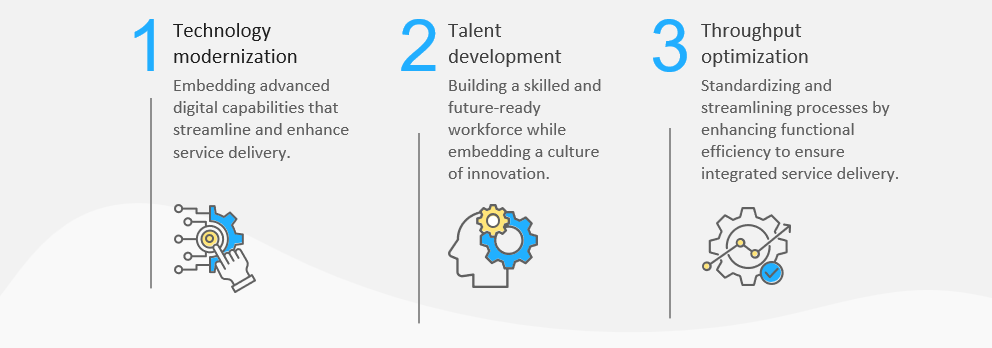
The evolution of Global Capability Centers (GCCs) and its respective landscape is marked by both rapid expansion and rising strategic importance. For example, for the second consecutive year, more than 300 new offshore and nearshore Global Capability Centers have been established globally.
Additionally, GCCs have moved beyond their early role as cost-arbitrage hubs delivering basic support functions such as IT services, back-office operations, and customer support. Today, they are increasingly playing a strategic role by driving digital enablement, owning end-to-end processes, and spearheading innovation that shapes enterprise-wide priorities.
With these evolving mandates, transformation has become a way for Global Capability Centers to expand their role and increase strategic relevance within enterprises. Without it, they risk being limited to transactional delivery, making them more vulnerable to being replaced by external service providers or competing in-house centers.
Read on to understand how Global Capability Centers can transform, where providers can assist in this process, and the key themes to be aware of during transformation, or get in touch.
Types of Global Capability Center transformation
GCC transformation can take different avenues. It can mean reimagining or transforming GCC’s own operations and service delivery to deliver higher-value outcomes, or it may involve leading transformation initiatives that drive broader enterprise-wide priorities. In either case, the scope extends from efficiency gains to delivering innovation, agility, and enterprise alignment. It spans three key pillars:

By focusing on these pillars, GCCs can reposition themselves as strategic entities, and not just execution engines.
Why GCCs struggle to do it alone
Despite the need and intent, many GCCs and enterprises struggle to drive the transformation agenda and achieve sustainable outcomes when acting independently. Common barriers include:
- Lack of strategic alignment and executive sponsorship: GCC transformations often lack a clear enterprise mandate, leaving initiatives fragmented and disconnected. In the absence of CXO-level advocacy, transformation initiatives struggle to gain enterprise-wide commitment. This limits funding continuity and causes the transformation to be perceived as discretionary rather than a strategic priority
- Resistance to change: Organizational inertia and fear of disruption often hinder the adoption of new systems, processes, and operating models. Without strong change management and cultural alignment, transformation is delayed and its impact is limited
- Limited in-house capabilities and technical expertise: Gaps in next-generation capabilities and solutions constrain GCCs’ ability to design, execute, and sustain transformation programs
- Weak integration with enterprise functions: Limited centralized decision-making at GCCs often results in process improvements that are not fully aligned with enterprise-wide operations. The absence of standardized processes and the use of disconnected systems further hinder collaboration, reduce transparency, and create misalignment with overall enterprise priorities
Together, these factors make GCC transformation a complex journey that requires substantial investment and alignment, which is difficult to achieve in isolation without prior experience.
Where providers come in
This is where providers play a critical role. Enterprises and GCCs are increasingly turning to providers to accelerate transformation. In Everest Group’s survey Mapping the Next: Key Priorities for 2025, 67% of enterprise/GCC leaders indicated they plan to engage providers to drive their transformation agenda. Providers act as catalysts, bringing the expertise, tools, and scalable models needed to help GCCs transition into enterprise-aligned, innovation-driven hubs.
Providers support GCCs in multiple ways:
- Redesigning functions and processes to standardize operations, improve efficiency, and enhance collaboration
- Modernizing technology and accelerating the adoption of next-generation capabilities such as Artificial Intelligence (AI), automation, and advanced digital platforms
- Running structured programs for talent upskilling, reskilling, and leadership development to build sustainable in-house capabilities
- Establishing transformation roadmaps and governance frameworks that ensure stronger alignment with enterprise priorities
Winning themes for providers
Competition in the GCC transformation space is intensifying, with different types of players bringing their own value propositions. Traditional service providers are leaning on their rich experience in technology and operations to expand their influence, while the Big 4 and McKinsey, Boston Consulting Group and Bain & Company (MBBs) are leveraging strong consulting pedigrees to capture more transformation-led mandates. On the other hand, niche providers are carving out space by focusing on specialized areas of operations and targeted expertise. Amid this variety, a few clear winning themes have emerged that highlight how providers are positioning themselves to capture opportunities and deliver lasting impact in the market:
- Deep expertise and focused commitment to the GCC market
Success in GCC transformation is often built on a strong foundation of dedicated strategy and domain expertise. Many providers have created dedicated GCC-focused practices, often staffed with ex-GCC leaders who bring hands-on experience in transformation. Consulting and advisory strengths add further credibility, while investments in GCC-specific leadership and delivery capabilities demonstrate long-term commitment. This focus has helped providers build enterprise trust and strengthen their positioning in the GCC transformation space
- Embedding transformation into day-to-day operations
Instead of treating transformation as a standalone project, such as setting up a digital Center of Excellence (CoE), some providers are embedding it directly into day-to-day service delivery. This means automation, process redesign, and adoption of new digital solutions are introduced gradually, without disrupting ongoing operations. By making transformation a continuous part of daily delivery, GCCs can evolve steadily, maintain stability, and scale innovation in parallel
- Making AI and next-gen innovation central to transformation
AI and next-generation technologies are increasingly positioned at the core of transformation, and not as add-ons. Providers are building orchestration platforms, embedding AI into industry and function-specific solutions, and investing in generative AI (gen AI) labs, tools, and accelerators. These investments strengthen GCC capabilities and speed up adoption of advanced digital solutions-to-end AI orchestration platforms
- Thought leadership and influence in the GCC market
Market success is strongly linked to the ability to actively shape the GCC narrative. Providers invest in GCC-focused thought leadership by conducting surveys, publishing insights, hosting flagship events, and participating in industry forums. These efforts strengthen their visibility and credibility, positioning them as trusted advisors to GCCs
- Building strong ecosystems through partnerships
In parallel, providers expand their impact through diverse partnerships. These include technology alliances with platforms such as AWS, Microsoft, Google Cloud, Oracle, and SAP, as well as non-tech collaborations with industry associations, and niche consulting firms. Such partnerships help providers stay aligned with both technological advancements and evolving talent and business needs while ensuring end-to-end service delivery
- Breadth and depth of transformation offerings
Providers also stand out by offering a comprehensive portfolio of services that cover the full spectrum of GCC transformation needs. Their capabilities span technology modernization, process redesign, talent development, and domain-specific expertise, allowing them to address both immediate operational priorities and long-term strategic goals. By combining depth in specialized areas with breadth across functions and industries, the providers can deliver integrated, end-to-end transformation solutions that align closely with enterprise objectives
Key takeaway
For GCCs, transformation is not optional, but the imperative action needed to remain competitive. The success of this journey depends on securing the right partner as a cornerstone of progress. Providers that demonstrate depth of expertise, embed transformation into daily delivery, make AI and innovation central, and build strong ecosystems will be best positioned to succeed. For enterprises, the recommendation is to evaluate providers not just on cost or scale, but on how they differentiate across these winning themes.
The GCC transformation market is becoming increasingly competitive, with traditional service providers, consulting firms, and niche specialists all sharpening their approaches to capture a larger share of this opportunity. For GCCs and enterprises, this means greater choice but also a greater need to identify the right partner, one that not only brings technical and functional expertise but can also align transformation with long-term enterprise priorities.
Everest Group GCC Transformation Capabilities in India PEAK Matrix® Assessment 2025


To understand how different providers are approaching this market and to deep-dive into who is leading and what sets them apart, explore our Global Capability Center (GCC) Transformation Capabilities in India – PEAK Matrix® Assessment 2025, or reach out to [email protected] or [email protected]











